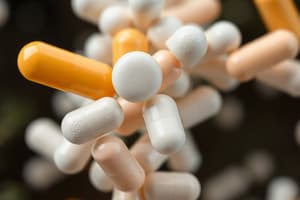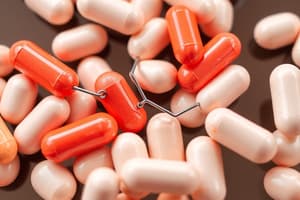Podcast
Questions and Answers
What is the mechanism of action of beta-lactam antibiotics?
What is the mechanism of action of beta-lactam antibiotics?
- Inhibition of protein synthesis
- Inhibition of cell wall synthesis by binding to specific receptors (PBPs) and inhibiting transpeptidase enzymes (correct)
- Disruption of cell membrane function
- Inhibition of DNA replication
What is the effect of beta-lactamase on the activity of beta-lactam antibiotics?
What is the effect of beta-lactamase on the activity of beta-lactam antibiotics?
- Increases antibacterial activity
- Has no effect on antibacterial activity
- Converts beta-lactam antibiotics to a more active form
- Decreases antibacterial activity (correct)
Which of the following is a characteristic of penicillin G?
Which of the following is a characteristic of penicillin G?
- It is resistant to gastric acid (correct)
- It is resistant to beta-lactamase
- It is primarily excreted in the bile
- It is a broad-spectrum antibiotic
What is the purpose of combining beta-lactam antibiotics with beta-lactamase inhibitors?
What is the purpose of combining beta-lactam antibiotics with beta-lactamase inhibitors?
Which of the following is a use of procaine and benzathine penicillin G?
Which of the following is a use of procaine and benzathine penicillin G?
What is the half-life of penicillin G?
What is the half-life of penicillin G?
What is the main difference between penicillin and cephalosporins?
What is the main difference between penicillin and cephalosporins?
What is the main mechanism of resistance to penicillin?
What is the main mechanism of resistance to penicillin?
Which of the following antibiotics is used to treat Staphylococcal infections?
Which of the following antibiotics is used to treat Staphylococcal infections?
What is the main advantage of using Piperacillin and Ticarcillin over Ampicillin and Amoxicillin?
What is the main advantage of using Piperacillin and Ticarcillin over Ampicillin and Amoxicillin?
What is the main characteristic of 3rd generation cephalosporins?
What is the main characteristic of 3rd generation cephalosporins?
What is the main route of elimination for most cephalosporins?
What is the main route of elimination for most cephalosporins?
What is the mechanism of action of Clindamycin?
What is the mechanism of action of Clindamycin?
What is the primary route of elimination of Clindamycin?
What is the primary route of elimination of Clindamycin?
Which of the following is a common mechanism of resistance to Clindamycin?
Which of the following is a common mechanism of resistance to Clindamycin?
What is a common side effect of Clindamycin?
What is a common side effect of Clindamycin?
What is a common indication for Clindamycin?
What is a common indication for Clindamycin?
What is the mechanism of action of quinupristin-dalfopristin against gram-positive cocci?
What is the mechanism of action of quinupristin-dalfopristin against gram-positive cocci?
What is the primary route of excretion for quinupristin-dalfopristin?
What is the primary route of excretion for quinupristin-dalfopristin?
What is the Primary indication for the use of quinupristin-dalfopristin?
What is the Primary indication for the use of quinupristin-dalfopristin?
What is the half-life of quinupristin?
What is the half-life of quinupristin?
What is the mechanism of resistance to quinupristin-dalfopristin?
What is the mechanism of resistance to quinupristin-dalfopristin?
What is the primary limitation of using linezolid?
What is the primary limitation of using linezolid?
What is the mechanism of action of sulfonamides?
What is the mechanism of action of sulfonamides?
What is the consequence of displacing bilirubin from plasma protein binding?
What is the consequence of displacing bilirubin from plasma protein binding?
What is the primary route of excretion for sulfonamides?
What is the primary route of excretion for sulfonamides?
What is the indication for Sulfasalazine?
What is the indication for Sulfasalazine?
What is the consequence of crystalluria in sulfonamide therapy?
What is the consequence of crystalluria in sulfonamide therapy?
What is the mechanism of action of Trimethoprim?
What is the mechanism of action of Trimethoprim?
What is the consequence of sulfonamide toxicity on the hematological system?
What is the consequence of sulfonamide toxicity on the hematological system?
What is the indication for Cotrimoxazole?
What is the indication for Cotrimoxazole?
What is the effect of sulfonamides on mammalian cells?
What is the effect of sulfonamides on mammalian cells?
What is the half-life of Sulfamethoxazole?
What is the half-life of Sulfamethoxazole?
Flashcards
Penicillin V
Penicillin V
A penicillin derivative particularly effective against infections in the mouth and throat after tooth removal.
Very-Narrow-Spectrum Penicillinase-Resistant Agents
Very-Narrow-Spectrum Penicillinase-Resistant Agents
A group of penicillins resistant to breakdown by penicillinase, an enzyme produced by some bacteria.
Methicillin
Methicillin
The first penicillin to be used against staph infections, now often used as a model drug for this purpose.
Methicillin-induced nephritis
Methicillin-induced nephritis
A major concern with methicillin, as it can cause inflammation of the kidneys.
Signup and view all the flashcards
MRSA & MRSE
MRSA & MRSE
Bacteria that have evolved to resist the effects of methicillin, posing a significant challenge for treatment.
Signup and view all the flashcards
Ampicillin and Amoxicillin
Ampicillin and Amoxicillin
Penicillin derivatives with a broader spectrum of activity, effective against a wider range of bacteria.
Signup and view all the flashcards
Synergistic effect
Synergistic effect
A phenomenon where two antibiotics work together to achieve a greater effect than when used alone.
Signup and view all the flashcards
Piperacillin and Ticarcillin
Piperacillin and Ticarcillin
Penicillin derivatives that primarily target gram-negative bacteria, which often cause infections in the lungs and urinary tract.
Signup and view all the flashcards
Cephalosporins
Cephalosporins
A class of antibiotics chemically distinct from penicillin.
Signup and view all the flashcards
Dihydrothiazine ring
Dihydrothiazine ring
A key structural feature of cephalosporins, differentiating them from penicillin.
Signup and view all the flashcards
Cephalosporin Generations
Cephalosporin Generations
A common way to classify cephalosporins based on their development, from 1st to 5th generations, with greater effectiveness against specific bacteria as they evolve.
Signup and view all the flashcards
Cephalexin
Cephalexin
A representative drug of the 1st generation of cephalosporins, effective mainly against gram-positive bacteria.
Signup and view all the flashcards
Pharmacokinetics
Pharmacokinetics
A detailed description of how a drug enters the body, circulates, and is eliminated.
Signup and view all the flashcards
Hepatic metabolism of cephalosporins
Hepatic metabolism of cephalosporins
Cephalosporins are primarily processed by the liver before being removed from the body.
Signup and view all the flashcards
Renal tubular excretion of cephalosporins
Renal tubular excretion of cephalosporins
The main route of elimination for most cephalosporins, involving excretion through the kidneys.
Signup and view all the flashcards
Ceftriaxone and Cefoperazone
Ceftriaxone and Cefoperazone
Two cephalosporins that are uniquely eliminated through bile, rather than the kidneys.
Signup and view all the flashcards
Cephalosporin resistance
Cephalosporin resistance
The ability of bacteria to develop resistance mechanisms against cephalosporins, often increasing with higher generations.
Signup and view all the flashcards
Clindamycin
Clindamycin
A potent antibiotic binding to the ribosome, disrupting protein synthesis.
Signup and view all the flashcards
Bacteriostatic Activity
Bacteriostatic Activity
The primary mechanism by which clindamycin exerts its antibacterial effect.
Signup and view all the flashcards
Anaerobic Infections
Anaerobic Infections
Severe infections caused by anaerobic bacteria, which thrive in oxygen-deprived environments.
Signup and view all the flashcards
Superinfection
Superinfection
One of the potential risks of using clindamycin, where harmful bacteria overgrow, leading to further complications.
Signup and view all the flashcards
Lincosamides
Lincosamides
A class of antibiotics that includes clindamycin, with similar mechanisms and effects.
Signup and view all the flashcards
Quinupristin/Dalfopristin
Quinupristin/Dalfopristin
A combination of two antibiotics, quinupristin and dalfopristin, specifically effective against resistant bacteria.
Signup and view all the flashcards
Bactericidal Activity
Bactericidal Activity
These antibiotics specifically target the ribosome to disrupt protein synthesis, leading to bacterial death.
Signup and view all the flashcards
Arthralgia-myalgia syndrome
Arthralgia-myalgia syndrome
A serious side effect of quinupristin/dalfopristin, involving pain in joints and muscles.
Signup and view all the flashcards
CYP3A4
CYP3A4
A group of enzymes involved in processing many drugs.
Signup and view all the flashcards
Oxazolidinones
Oxazolidinones
Antibiotics that inhibit the formation of new proteins in bacteria by binding to the ribosome.
Signup and view all the flashcards
23S rRNA
23S rRNA
A crucial component of the ribosome, the site where oxazolidinones bind to exert their effects.
Signup and view all the flashcards
Sulfonamides
Sulfonamides
A subclass of antibiotics that specifically target the synthesis of folic acid, a crucial nutrient for bacterial growth.
Signup and view all the flashcards
PABA (para-aminobenzoic acid)
PABA (para-aminobenzoic acid)
A key chemical compound essential for bacterial growth, a target for sulfonamide antibiotics.
Signup and view all the flashcards
Trimethoprim
Trimethoprim
Another type of antibiotic that inhibits folic acid synthesis in a different way.
Signup and view all the flashcards
Cotrimoxazole
Cotrimoxazole
A combined therapy using trimethoprim and sulfamethoxazole, enhancing effectiveness against infections.
Signup and view all the flashcards
Hypersensitivity Reactions
Hypersensitivity Reactions
A common side effect of sulfonamides, characterized by an immune response to the drug.
Signup and view all the flashcards
Beta-lactam Antibiotics
Beta-lactam Antibiotics
A broad category of antibiotics that target the cell wall of bacteria.
Signup and view all the flashcards
Transpeptidase enzymes
Transpeptidase enzymes
The primary enzyme inhibited by beta-lactam antibiotics, responsible for building the bacterial cell wall.
Signup and view all the flashcards
Enzymatic hydrolysis
Enzymatic hydrolysis
The breakdown of beta-lactam antibiotics by certain bacteria, leading to resistance to therapy.
Signup and view all the flashcardsStudy Notes
Penicillin and its Derivatives
- Penicillin V: Effective for oropharyngeal infections following dental extraction.
- Very-Narrow-Spectrum Penicillinase-Resistant Agents: Includes Methicillin, Nafcillin, and Oxacillin; resistant to penicillinase.
- Methicillin: Prototype agent for treating staphylococcal infections; known to cause nephritis.
- Resistance: MRSA (methicillin-resistant Staphylococcus aureus) and MRSE (methicillin-resistant Staphylococcus epidermis) are resistant to methicillin.
- Ampicillin and Amoxicillin: Broader spectrum; effective against Enterococci, E. coli, H. influenzae, L. monocytogenes (dangerous for pregnant women), P. mirabilis, and M. catarrhalis. Synergistic effect with aminoglycosides.
- Piperacillin and Ticarcillin: Target gram-negative bacteria, including Pseudomonas, Enterobacter, and Klebsiella species; also show synergy with aminoglycosides.
Cephalosporins
- Structural Characteristics: Cephalosporins differ from penicillins with a dihydrothiazine ring and acyl side chains (R1 and R2).
- Generations: Classified based on their development; 1st Generation (Cephalexin, Cefazolin) generally targets Gram-positive bacteria.
- Pharmacokinetics: Metabolized in the liver, mainly excreted via renal tubular excretion, except Ceftriaxone and Cefoperazone (excreted in bile).
- Resistance: Cephalosporins exhibit varying resistance profiles from 1st to 3rd Generation, increasing coverage against Gram-negative organisms.
Clindamycin and Lincosamides
- Clindamycin: Binds to the 50S ribosomal subunit, exhibiting bacteriostatic activity; effective against Gram-positive cocci and anaerobic bacteria.
- Toxicities: Can lead to severe anaerobic infections, skin rashes, toxic shock syndrome, and superinfections.
- Combination Therapy: Often paired with aminoglycosides for serious infections such as necrotizing fasciitis.
Streptogramins
- Quinupristin/Dalfopristin: Bactericidal against most Gram-positive cocci; effective against MRSA and vancomycin-resistant E. faecium.
- Mechanism: Binds to the 50S ribosomal subunit, causing protein synthesis disruption.
- Toxicities and Drug Interactions: May cause arthralgia-myalgia syndrome; interacts with drugs metabolized by CYP3A4.
Oxazolidinones
- Linezolid and Tidezolid: Bind to the 23S rRNA of the 50S ribosomal subunit; prevent ribosome formation and exhibit bacteriostatic activity against streptococci.
Sulfonamides and Trimethoprim
- Sulfonamides: Bacteriostatic agents that inhibit folic acid synthesis by competing with PABA; used for uncomplicated UTIs and ocular infections.
- Trimethoprim: Inhibits dihydrofolate reductase, blocking the formation of active tetrahydrofolate.
- Cotrimoxazole: Combination of trimethoprim and sulfamethoxazole; provides synergistic inhibition of folate synthesis and expanded activity against various infections.
- Toxicities: Potential for hypersensitivity reactions, gastrointestinal disturbances, and hematologic toxicity.
General Pharmacokinetics and Resistance
- Basic Mechanism of Action (MOA): Beta-lactam antibiotics disrupt cell wall synthesis by inhibiting transpeptidase enzymes, leading to bacterial cell lysis.
- Resistance: Common mechanisms include enzymatic hydrolysis by beta-lactamases and modifications in target sites.
Important Considerations
- Drug Interactions: Some antibiotics displace other drugs from plasma proteins, potentially increasing their free concentrations and toxicity.
- Adverse Effects: Includes skin toxicity, gastrointestinal upsets, and possible renal implications, necessitating cautious use in specific populations, such as the elderly or with pre-existing conditions.
Studying That Suits You
Use AI to generate personalized quizzes and flashcards to suit your learning preferences.



